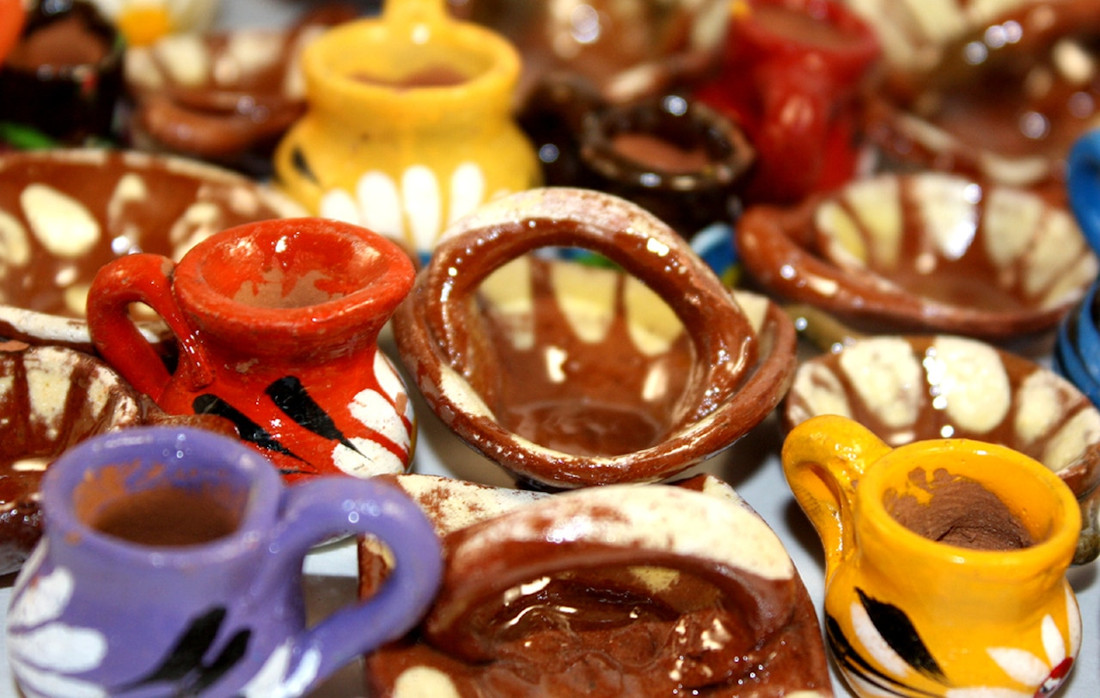by Pat Hall
I've been wanting to take a course in Nahuatl, the language of the Aztecs, for a long time. Finally, with lots of time being quarantined at home these days, I did, virtually. My instructor lives in Mexico City. He would email me exercises and we would have an hour-long lesson on the phone twice a week. I learned a lot.
My interest in Nahuatl began when I lived in Cholula, Puebla in the 1970s. There I went to the Friday Market every week and always bought my veggies from the same woman. Wanting to expand our acquaintance, I tried starting a conversation in Spanish with her, but the only reaction I got was a blank stare. I found out that she only spoke Nahuatl. She came into Cholula for the market from one of the outlying villages, where only Nahuatl was spoken. The only Spanish words she knew were those she had learned for the market, prices and the names of the merchandise she sold.
First things first, for a long time I had a burning question about the meaning of the name itself, Nahuatl. I was amazed to learn its origins; Nahui means the number "four" and atl means "water." Therefore Nahuatl means water in all four directions (north, south, east, and west). The fact that the Aztecs built Tenochtitlan (Mexico City) on a big lake fits right in; water in all four directions.
It seems, the wandering Aztecs were told by their gods to build their new city where they saw an eagle perched on a cactus devouring a snake. This image did appear to them, but in an unlikely place – on a tiny island in the middle of Lake Texcoco. But no matter, they still built their city there. The city gradually spread through the construction of artificial islands to cover more than 13 square kilometres, and was connected to the mainland by several causeways. The city in 1519 when the Spanish conquistadors arrived was estimated to have between 200,000 to 400,000 people, alongside Paris and Constantinople, amongst the largest in the world.

It is said that the Nahuatl language has "el sonido de las cuatro aguas," "the sound of the four waters." This means that the language has musical rhythm and cadence. That explanation sheds light on a mystery that has always baffled me: why does Mexican Spanish have a definite musical cadence and rhythm unlike Spanish from other countries? Of course, now it's clear. Mexican Spanish still has the musical cadence and rhythm coming through from the ancestral Nahuatl language. In Chihuahua, in northern Mexico, the rapid-fire Spanish doesn't have either rhythm or cadence, because the Aztecs didn't settle there.
Many common words in Mexican Spanish that have spread around the world to other languages come from the Nahuatl — chocolate, coyote, atole, tomate, chicle, etc. I'm amazed that as far away as in Canada we use the English word "coyote" that comes from the Nahuatl. There are lots of coyotes in Canada. In Mexico they use the word elote for "corn", from the Nahuatl word elotl, while other Spanish-speaking countries use the word maíz. In central Mexico where the Aztecs were, the word jitomate from the Nahuatl word xictomatl, is used for the red type of tomato while tomate is the green type of tomato. The rest of the Spanish-speaking world just uses one word for both "tomate".

The Aztecs believed that cacao seeds were the gift of Quetzalcoatl, the god of wisdom. In their culture the seeds once had so much value that they were used as a form of currency. Originally prepared only as a drink, chocolate (xocoatl in Nahuatl) was served as a bitter liquid, mixed with spices.
The word chicle comes from the Nahuatl word for "gum", tzictli, which can be translated as "sticky stuff." Before chiclets, there was gum, oozing from jungle trees like melting candle wax under the slash of a machete. The Aztecs figured out that by slicing the bark of the sapodilla tree strategically, they could collect this resin and create a chewable substance from it. Chicle quenched thirst and staved off hunger. The Aztecs also recognized chicle's function as a breath-freshener. Interestingly, however, the Aztecs seemed to view public gum chewing as socially unacceptable for adults. Women who dared to chew chicle in public were viewed as harlots, while men who did so were thought effeminate. Warfare was a fundamental part of Aztec culture. All males expected to actively participate and those guys were tough! Maybe this has influenced the machismo in Mexico. But I don't see what that had to do with chewing gum.

Do you know why the mountain, Popocatepetl, is so named? Popoca means "to smoke" in Nahuatl and tepetl is the word for "mountain." The name of the city of Mazatlán comes from the Nahuatl word for "deer." I guess there were lots of deer there. The city of Tlaxcala gets its name from the Nahuatl word for "tortilla" (tlaxcalli). Be careful though, because that's only a wheat tortilla, not a corn tortilla.
I've always wondered about that place called Tlaquepaque. What a name! Who would ever give a name like that to a place? Well, in Nahuatl tlalic-pac means "over clay hills" and came to mean "men who make clay utensils with their hands." Tlaquepaque had a tradition of fine craftsmanship long before the Spanish came. The pottery that they still sell there these days is so beautiful. Now I know how the town got its name. Such fun!

For those of you who have problems learning and remembering Spanish verb conjugations, you'll be pleased to know that Nahuatl doesn't do anything like that. Instead of putting different endings on a verb to change the subject, they just put prefixes on the front of the verb to show the change of subject. And, of course, once you learn the prefixes for the pronoun subjects, you can conjugate any verb. For example, the prefix ni- is always placed at the front of a verb if the subject is "I." The third person singular (he/she) form of the verb is also used as the infinitive. Therefore popoca means "he/she smokes" or "to smoke." How's that for simple?
I do have to tell you though, that the plural of a verb has an -h placed at the end of the verb. But that's still a lot easier than our system in English and in Spanish and in other languages of changing the endings on a verb, and the changes depend on the type of verb, etc. I've never encountered a language that has such a simple system for verbs and I love it. There are a few irregular verbs, but not many.

The basic rule for pronunciation is simple -- always stress the second-to-last syllable. That's why it's Popocatepetl. There is no need for accents in Nahuatl.
Pronunciation is a challenge, but only because the words are so long. Quite often one word will be joined to another and then to another, and then another, creating compound words. That makes the words really long. A good example of this "agglutination" is the Nahuatl word, iztacteocuitlayochapolco, which means "in the house of the silver-coloured grasshopper."
It has been said that Mexican Spanish is easier to learn than Spanish in other countries because Mexicans speak their language more slowly than other Spanish-language speakers. No wonder it's slower in Mexico because of the Nahuatl influences. If you tried saying the Nahuatl word, iztacteocuitlayochapolco, really fast, I don't what might happen to you. Just try saying Popocatepetl, or his girlfriend, Iztaccíhuatl (white woman = covered in white snow) really fast and you'll soon be tongue-tied.
I thought I would share these thoughts about the Nahuatl language with you because I find it amazingly interesting. It explains so much of the culture and language here in Mexico. Varieties of Nahuatl are still spoken today by about 1.7 million Nahua people, most of whom live in central Mexico.
**************

Pat Hall is a retired Canadian who has been visiting San Miguel for the past 22 years. Many years ago Pat worked in the library at the Universidad de las Américas in Cholula, Puebla for three years where she also studied Spanish. In Canada she worked as a librarian, library science instructor, and language teacher (French, Spanish, German, Latin, and English as a Second Language). The last 8 years of her working life were spent as a translator, translating official documents from Spanish to English and from English to Spanish. She has recently published a book, Speak To Me: Travels and Exploits of a Language Lover, available on Amazon, about her adventures traveling and pursuing her passion for languages.
